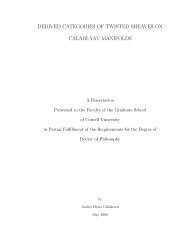A Course on Large Deviations with an Introduction to Gibbs Measures.
A Course on Large Deviations with an Introduction to Gibbs Measures.
A Course on Large Deviations with an Introduction to Gibbs Measures.
Create successful ePaper yourself
Turn your PDF publications into a flip-book with our unique Google optimized e-Paper software.
xii Preface (<strong>an</strong>d <strong>to</strong> the reviewers)<br />
theorem, S<strong>an</strong>ov’s theorem, <strong>an</strong>d the process level LDP for i.i.d. variables<br />
indexed by a multidimensi<strong>on</strong>al square lattice.<br />
Part II introduces <strong>Gibbs</strong> measures <strong>an</strong>d proves the Dobrushin-L<strong>an</strong>ford-<br />
Ruelle variati<strong>on</strong>al principle that characterizes tr<strong>an</strong>slati<strong>on</strong>-invari<strong>an</strong>t <strong>Gibbs</strong><br />
measures in terms of the v<strong>an</strong>ishing of a large deviati<strong>on</strong> rate functi<strong>on</strong> <strong>an</strong>d<br />
in terms of a minimizati<strong>on</strong> problem. After this we proceed <strong>to</strong> study the<br />
phase tr<strong>an</strong>siti<strong>on</strong> of the Ising model. We also pl<strong>an</strong> <strong>to</strong> add a secti<strong>on</strong> <strong>on</strong> the<br />
Fortyin-Kasteleyn r<strong>an</strong>dom cluster model <strong>an</strong>d cover the modern percolati<strong>on</strong><br />
approach <strong>to</strong> phase tr<strong>an</strong>siti<strong>on</strong>s.<br />
Part III develops the large deviati<strong>on</strong> themes of Part I in several directi<strong>on</strong>s.<br />
<strong>Large</strong> deviati<strong>on</strong>s of i.i.d. variables are complemented <strong>with</strong> moderate<br />
deviati<strong>on</strong>s <strong>an</strong>d <strong>with</strong> more precise large deviati<strong>on</strong> asymp<strong>to</strong>tics. From i.i.d.<br />
processes we generalize <strong>to</strong> Markov chains <strong>an</strong>d <strong>to</strong> independent but n<strong>on</strong>stati<strong>on</strong>ary<br />
processes. The latter <strong>to</strong>pic gives us the opportunity <strong>to</strong> introduce<br />
<strong>an</strong> entirely different way of proving large deviati<strong>on</strong> principles, namely the<br />
Baxter-Jain theorem. This material has not previously appeared in textbooks.<br />
We are also pl<strong>an</strong>ning a secti<strong>on</strong> <strong>on</strong> large deviati<strong>on</strong>s for some flavor of<br />
r<strong>an</strong>dom walk in r<strong>an</strong>dom envir<strong>on</strong>ment.<br />
The reader should note that starred exercises are used in the text later<br />
<strong>on</strong>. Also, Dembo <strong>an</strong>d Zei<strong>to</strong>uni c<strong>on</strong>tain thorough his<strong>to</strong>rical notes <strong>an</strong>d references,<br />
hence we have not attempted <strong>to</strong> present the his<strong>to</strong>rical record.<br />
The ideal background for reading this book would be some familiarity<br />
<strong>with</strong> the l<strong>an</strong>guage of measure-theoretic probability, <strong>an</strong>d <strong>with</strong> <strong>an</strong>alysis<br />
in general so that the reader is comfortable working <strong>with</strong> noti<strong>on</strong>s such as<br />
lower semic<strong>on</strong>tinuity or <strong>with</strong> linear spaces. In reality our courses have been<br />
populated by students <strong>with</strong> diverse backgrounds, m<strong>an</strong>y <strong>with</strong> less th<strong>an</strong> ideal<br />
knowledge of <strong>an</strong>alysis <strong>an</strong>d probability. To make the material accessible <strong>to</strong><br />
these students we pl<strong>an</strong> <strong>to</strong> enh<strong>an</strong>ce the appendixes <strong>to</strong> include <strong>an</strong> overview<br />
of the main theorems of measure theory <strong>an</strong>d probability. (And <strong>on</strong>ce we do<br />
this the frequent references <strong>to</strong> basic probability textbooks that now interrupt<br />
the flow of the prose will disappear.) The actual technical needs for<br />
following the book are not deep <strong>an</strong>d it should be possible for <strong>an</strong> instruc<strong>to</strong>r<br />
<strong>to</strong> accommodate students <strong>with</strong> quick lectures <strong>on</strong> <strong>an</strong>alytic technicalities<br />
whenever needed. We have found that there is great interest in probability<br />
theory am<strong>on</strong>g students of ec<strong>on</strong>omics, engineering <strong>an</strong>d sciences. This interest<br />
should be encouraged <strong>an</strong>d nurtured <strong>with</strong> accessible courses.<br />
We are of course greatly indebted <strong>to</strong> the existing books <strong>on</strong> the subject,<br />
especially those by Amir Dembo <strong>an</strong>d Ofer Zei<strong>to</strong>uni, Je<strong>an</strong>-Dominique Deuchel<br />
<strong>an</strong>d D<strong>an</strong>iel Stroock, Fr<strong>an</strong>k den Holl<strong>an</strong>der, <strong>an</strong>d Richard Ellis. We th<strong>an</strong>k Jeff<br />
Steif for lecture notes that helped shape the proof of Theorem 10.2, Jim<br />
Kuelbs for the material for Secti<strong>on</strong>s 12.1 <strong>an</strong>d 12.2, <strong>an</strong>d Chuck Newm<strong>an</strong> for
















